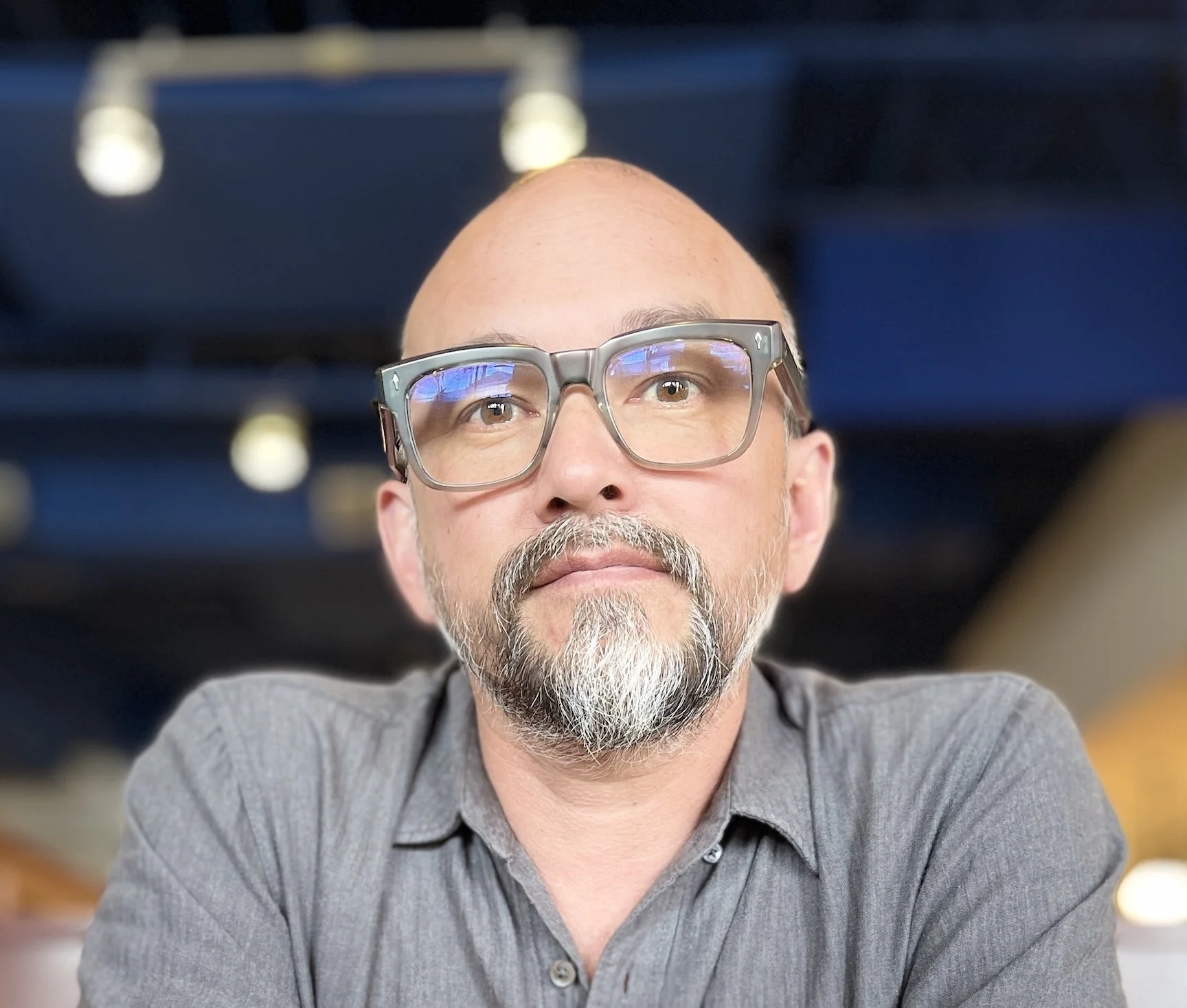Interview with artist Trevor Segraves
Trevor Segraves is an artist based in Northwest Arkansas. Oil is his medium of choice, and his refined and labor-intensive process creates paintings that have wonderfully enhanced depth and texture. His most recent works are a merger of pop culture icons and iconic works of art. More of Trevor’s paintings can be found at his Instagram and at his September solo show at McCoy Gallery, Walton Arts Center's Community Creative Center in Fayetteville.
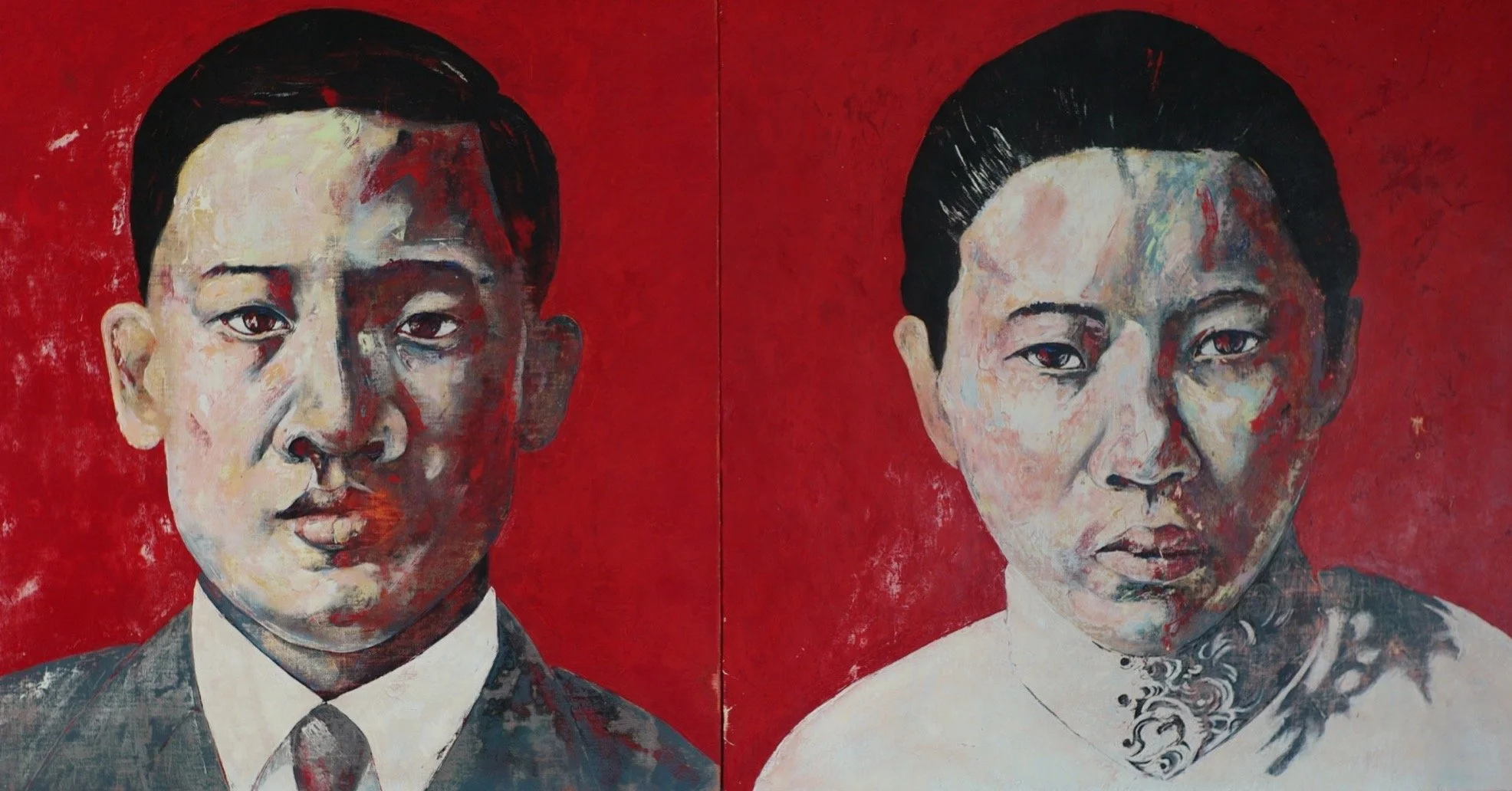
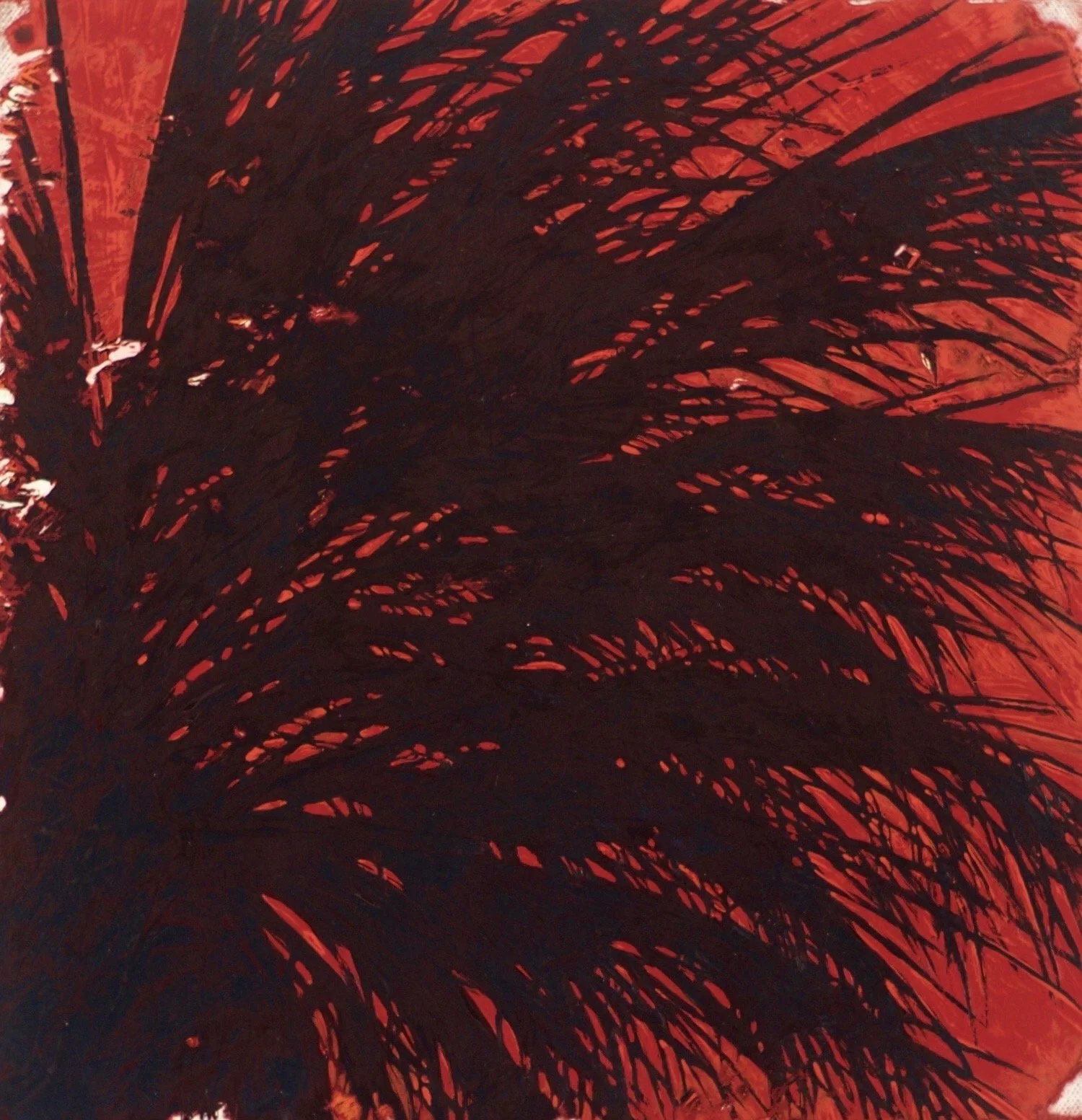
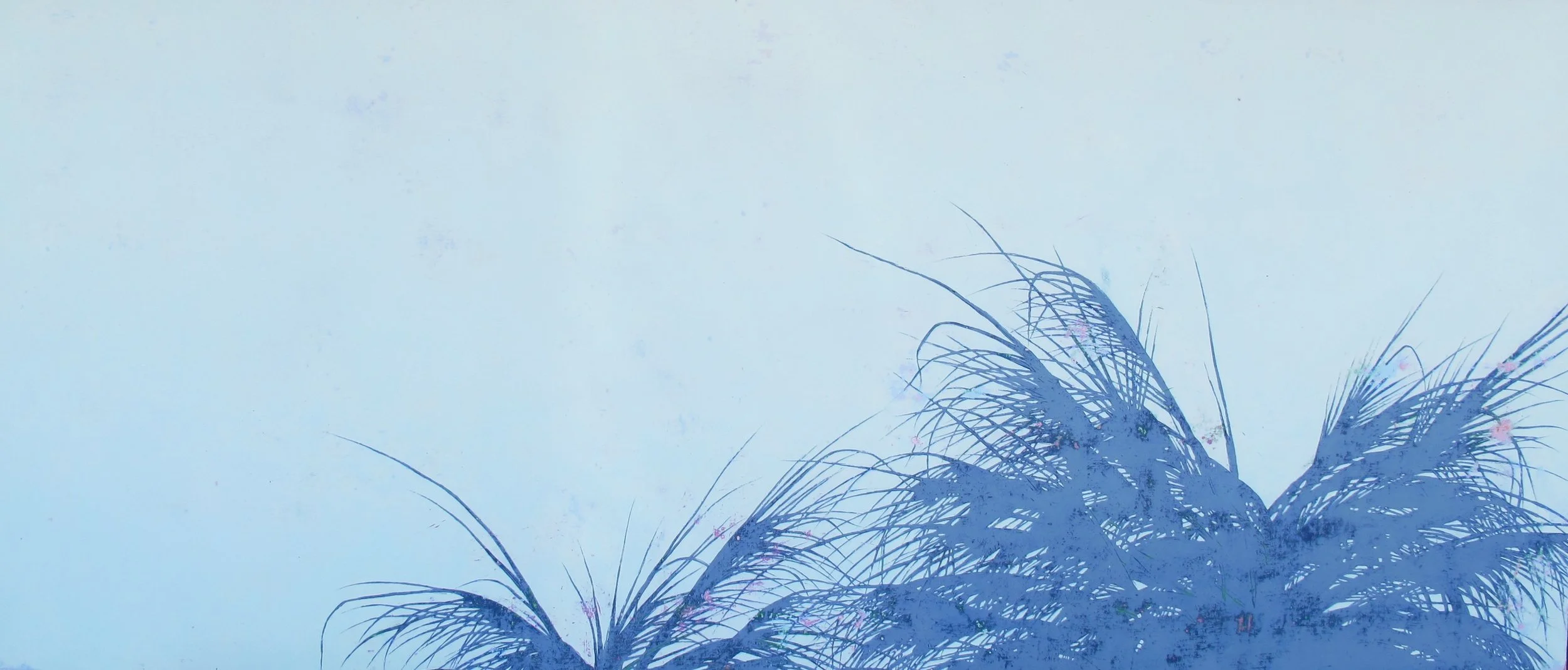


AAS: Trevor, tell me about yourself. Are you originally from Arkansas?
TS: No, I’m actually a California native—born and raised in Orange County. I grew up in a big, lively family with three brothers, two sisters, and my parents, so there was never a dull moment! I married my high school sweetheart, and we started our family young—we had two kids by the time we were 20.
My love for art took me overseas in 1996, where I spent a year studying at the University of London. After that, we moved to Iowa, and I earned my BFA from the University of Iowa in 2000. Then it was back to California, where I got my MFA from Cal State Fullerton and began exhibiting my work across Southern California.
In 2017, life brought us to Northwest Arkansas to help care for my wife’s family. It’s been a great change of pace—I’ve even found new creative inspiration in the natural beauty and growing arts scene here.
AAS: Was art something you were exposed to much growing up?
TS: Absolutely—art was a part my life from the very beginning. While my older brothers were out surfing and playing sports, you'd usually find me in my room, completely absorbed in drawing, painting, and listening to music. I knew I wanted to be an artist for as long as I can remember—it was never really a question.
Some of my most vivid childhood memories are visiting museums in Los Angeles and galleries in Laguna Beach. Those experiences lit a spark in me that never faded. My biggest early inspiration was actually my eldest brother, Sean. He's six years older than me, and at the time, I thought he had the coolest job in the world—he was an artist for Tower Records, painting those massive album cover murals that covered the store walls. Watching him recreate those iconic 80s album covers definitely shaped my idea of what an artist could be.
AAS: What artists or style of art inspire you?
TS: I've always been drawn to the West Coast Pop Art movement - artists like Wayne Thiebaud with his deliciously thick paint and nostalgic Americana, David Hockney's vibrant California light, Ed Ruscha's urban landscapes, and especially Llyn Foulkes, whose raw, unsettling narratives really speak to me.
Beyond visual art, I was deeply influenced by the Post-Punk and New Wave music scene of the 1980s. The dark energy of Goth Rock and the DIY aesthetic of that era definitely seeped into my current work - you can see it in the narrative quality and slightly subversive edge in my paintings.
“My work often returns to that adolescent sense of wonder, when the world still felt full of undiscovered places and unlimited potential.”
AAS: I want to ask your first about your more recent work, which I first became aware of from the last three Small Works on Paper exhibitions. Sea of Somnia is a beautifully executed piece. Is it in reference to your dreams as a kid?
Sea of Somnia, 30” x 36”, oil on linen
TS: Yes, though perhaps more specifically about childhood nostalgia itself. The folded paper boat references those afternoons my little sister and I spent immersed in origami. That simple notebook paper vessel carries so much personal meaning.
The painting actually weaves together several visual touchstones from my childhood - Rembrandt's stormy Sea of Galilee, the powerful curves of Hokusai's Great Wave, and even Sendak's magical journey in Where the Wild Things Are. There's that beautiful moment when Max sails away to where the wild things roam - that sense of childhood possibility, when every folded paper boat could actually carry you to some extraordinary place. My work often returns to that adolescent sense of wonder, when the world still felt full of undiscovered places and unlimited potential.
AAS: I should ask you next about your terrific series of paintings featuring Howdy Doody. What inspired what some might call an irreverent and provocative series?
TS: This series draws from the collision of childhood nostalgia and historical reckoning. Howdy Doody represented an idealized, postwar America - that mythic time when the 'American Dream' supposedly flourished, though only for some. By placing this innocent icon in violent historical contexts, I wanted to confront our national narratives. These paintings ask: what happens when we subject our cultural or current icons to the same scrutiny we apply to history?
Trevor’s home studio.
Howdy Crossing Mount Ta'Amulah replaces Napoleon in David's propaganda portrait. The title uses the Hebrew word for propaganda, highlighting how figures like Napoleon - or Howdy - become tools for crafting national mythology.
The Death of Doody directly references Jacques-Louis David's The Death of Marat, but with Princess Summerfall Winterspring - the show's stereotyped Native character - as the assassin. This coincided with national conversations about the Osage murders, Black Wall Street, and residential school gravesites. The painting became about awakening to uncomfortable truths.
Made in China reimagines Eddie Adams' Pulitzer-winning Saigon Execution photograph. As a post-Vietnam War kid, this image symbolized war's brutality and its power to shift public opinion. The title came when I noticed 'CHINA' stamped on a toy soldier's back - a perfect metaphor for how violence becomes commodified.
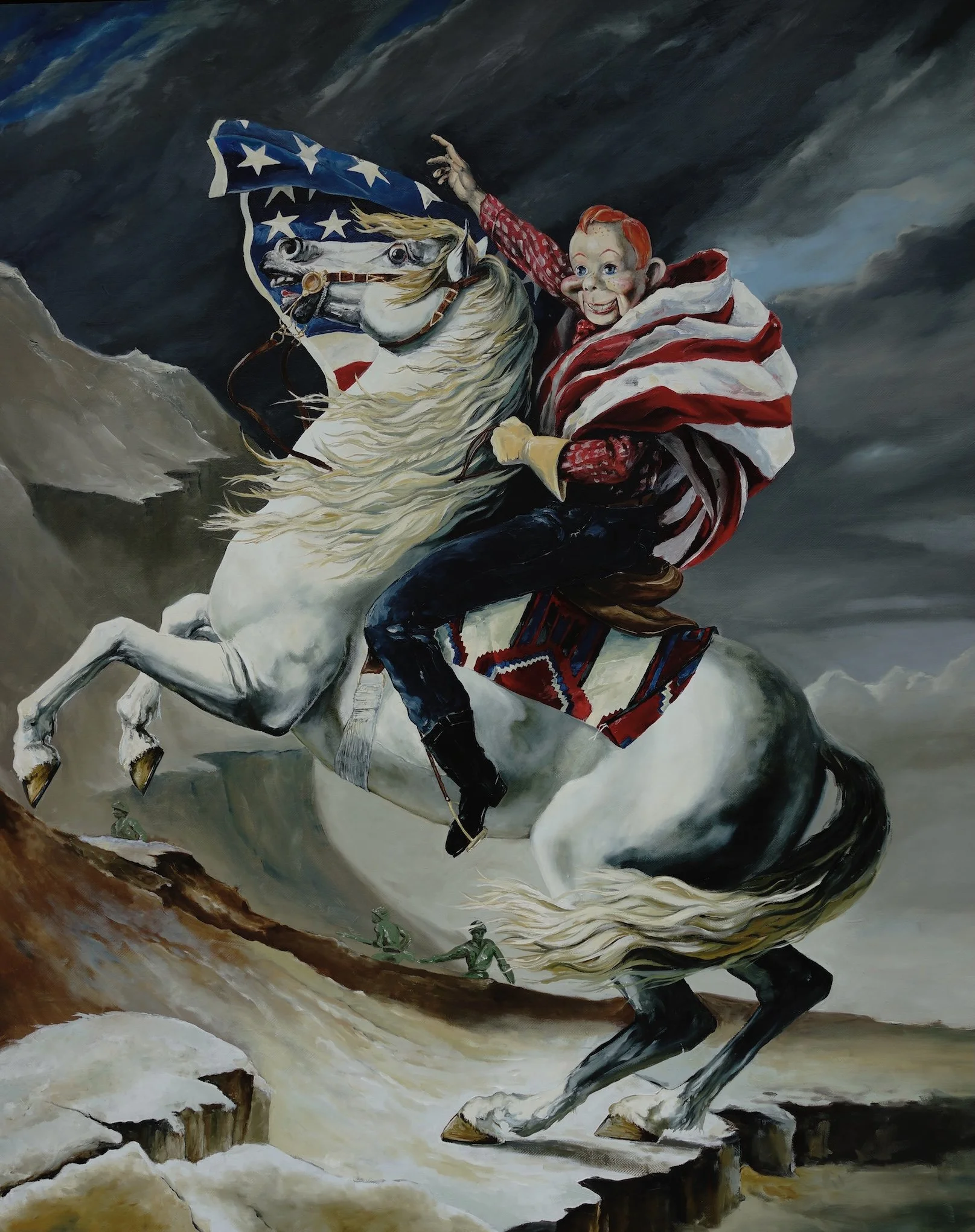


“The juxtaposition of Renaissance sacred art with mid-century pop culture creates this tension between reverence and irreverence that I find endlessly compelling.”
AAS: One of my favorites of your recent paintings has two equally appropriate titles: My Name is Talky Tina, and you better be nice to me or Pieta at the Union 76. Tell me about that spooky but comical image.
My Name is Talky Tina, and you better be nice to me or Pieta at the Union 76, 18” x 18”, oil on linen
TS: This painting brings together several of my earliest childhood fascinations in one composition. It reimagines Michelangelo's Pietà, substituting the Virgin Mary and Christ with two iconic figures from my youth: the sinister Talky Tina from The Twilight Zone and Pinocchio.
Every holiday, my little sister and I would watch The Twilight Zone marathons, and Talky Tina's episode always stood out - she's essentially the prototype for every killer doll story that followed, from Chucky onward. What I love about her is that menacing quality that only those 'in the know' would recognize - it becomes this wonderful inside joke for horror fans.
Pinocchio made perfect sense as the Christ figure - I actually used my own vintage Pinocchio doll from my collection as reference. As for the Union 76 backdrop, it just felt right. Like the other elements, that glowing orange ball logo occupies this romantic, nostalgic space in my memory. The juxtaposition of Renaissance sacred art with mid-century pop culture creates this tension between reverence and irreverence that I find endlessly compelling.
AAS: I want to ask you next about some of your work from a few years ago. The style and subject matter are quite different as is the overall look. Many are portraits and two in particular, El and Sean are remarkable in their style and feel. What do you like about portraiture?
TS: Portraiture has always been part of my practice, and I imagine it always will be. These two particular works carry deep personal significance for me. El was painted for my father, who had long asked me for a portrait of my mother. The reference was a small wallet-sized photo she had given him, simply signed 'Love, El' - short for Elberta. There's something profoundly intimate about working from such a humble, well-loved image.
Sean emerged from one of the most difficult periods of my life. After my brother's terminal cancer diagnosis in 2014, I spent his last six months documenting our time together - photographing him, talking with him. I can still picture him sitting there, smoking his cloves (two packs a day), asking me, “Trev, do you think I can beat this?” That portrait holds all those memories - the hope, the fear, the inevitable goodbye.
What draws me to portraiture is precisely this emotional weight - the way a face can become a vessel for memory, for relationship, for moments both ordinary and profound. Yes, I still paint portraits, because there's no form that feels quite as immediate or human.
El, (Mom), 36” x 36”, oil on linen
Sean, 24” x 24”, oil on linen
AAS: Oh, sorry, it must have been a very difficult time for you. Can you explain more about the technique you used to achieve that look?
TS: It's an incredibly layered process - quite literally. Each painting builds up through 40-50 successive layers of paint. I begin by applying the highlights thickly in the early stages, then gradually bury them beneath subsequent layers. The final transformative step involves aggressively sanding the surface with an electric sander - this both reveals glimpses of those buried underlayers and creates an almost glass-smooth finish.
With Sean's portrait, I incorporated an additional element - 22k gold leaf woven throughout the layers. It's subtle, something that photographs can't quite capture, but in person it creates this quiet luminosity, like memory itself shimmering just beneath the surface.
AAS: Tell me about Eliana V and your collaboration with NUMERaTA Wine Company.
NUMERaTA wine bottle
TS: Eliana V represents a wonderful creative partnership with winemaker Greg Fitzgerald and his NUMERaTA Wine Company. Greg is an incredibly talented vintner, and we developed this special project where I would create annual portrait labels for his premium pinot noir - each year capturing his daughter Eliana at a new stage of her life.
These portraits use the same meticulous, multi-layered technique as my El and Sean paintings - building up 40-50 layers of paint, then carefully sanding to reveal glimpses of the underlying history. There's something poetic about applying this time-intensive process to a project that itself documents the passage of time. The wine becomes not just a vintage, but a visual chronicle of growth and transformation.
Eliana V, 15” x 20”, oil on linen
AAS: Congratulations on your upcoming solo show at the Walton Arts Center in Fayetteville! Is it a retrospective or mostly of your recent work?
TS: Thank you! The show, which will feature primarily my recent paintings, will be held in the McCoy Gallery at the Walton Arts Center's Community Creative Center location. Mark your calendars for September 1-30, with an opening reception on September 5th from 5-8 PM.
It's particularly meaningful to have this exhibition in Fayetteville - a chance to share my newest work with the community that's become our home.
AAS: Trevor, where do you think your art practice will lead you next?
TS: I've learned to approach my practice one painting at a time. The pandemic unexpectedly became a creative turning point for me - it stripped away pretenses and pushed me toward more immediate, narrative work. That revelation continues to guide me. While I can't predict exactly what forms my art will take, I know it will always respond to what moves me in the world around us.
What I can say for certain is that I'm committed to deepening my engagement with Arkansas' vibrant art community. And none of this journey would be possible without my wife Bridgette - for 35 years she's been my constant supporter, my honest critic, and my anchor through every creative evolution. As long as I have her belief and my brushes, I'm excited to see where the path leads next.
